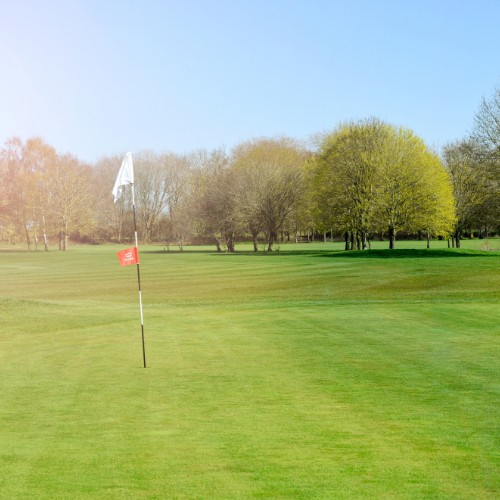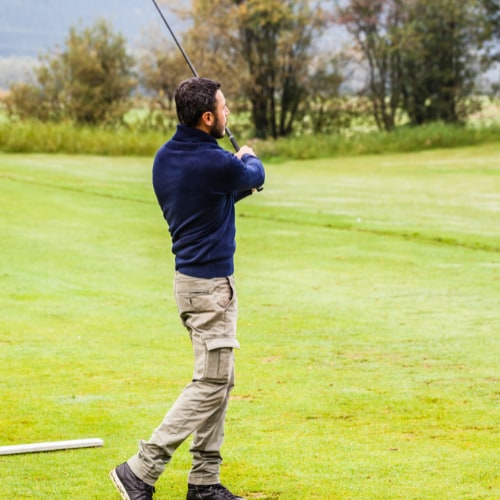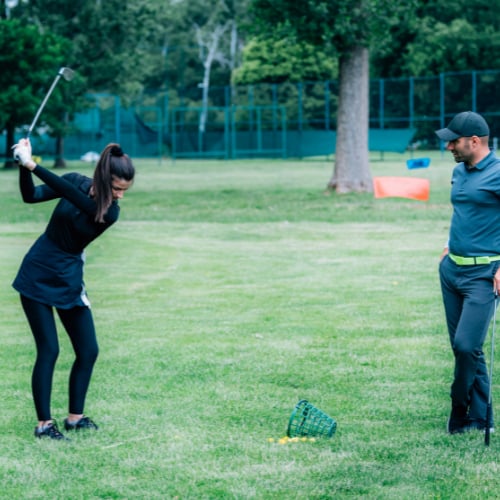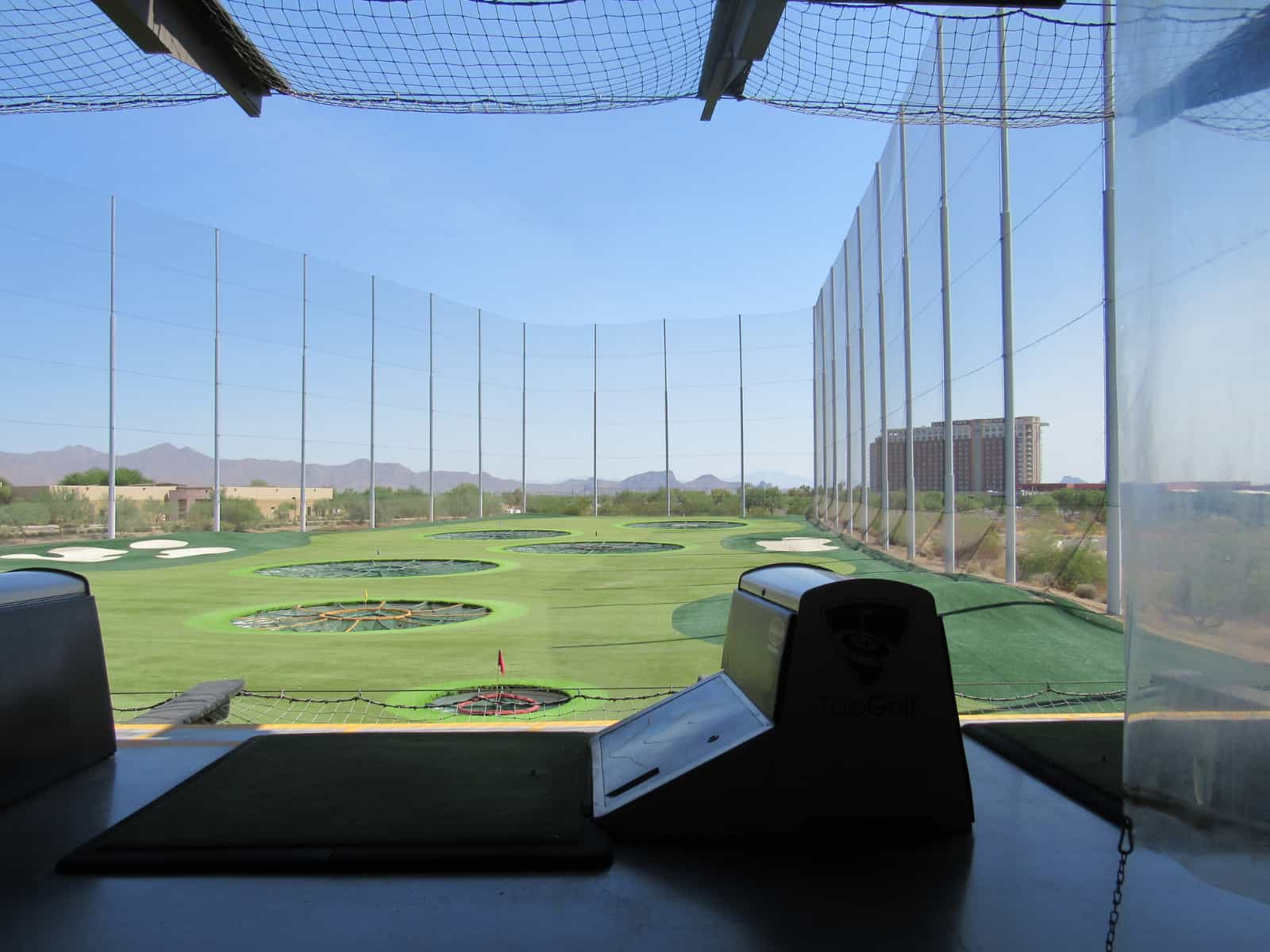As a beginner golfer, going to the driving range can be overwhelming and intimidating. However, frequent practice sessions at the driving range are crucial in building and improving your golf game.
The driving range is an essential place where you can work on your swing, technique, and distance control without worrying about the pressure of playing an actual golf game. This is where technical practice comes in, and it’s important to work on technique and form before moving on to competitive practice.
In this article, we will provide you with driving range tips for beginners to make the most out of your practice sessions.
Keep reading for the details.
Driving Range Tips For Better Practice Sessions

The driving range is a great place to work on your skills and improve your technique. Here are some driving range tips to make the most out of your practice sessions as a beginner.
1. Start With Proper Focus
As a beginner golfer, it’s important to set objectives before stepping onto the driving range. By setting a clear goal, you can channel your focus and make your practice sessions more effective and efficient.
One way to do this is by breaking down your swing into individual pieces and focusing on improving each one. By doing so, you can gradually improve your overall swing and become more accurate.
Focusing on hitting the ball straight is an excellent goal to start with. To do so, Ensure that your grip is not too tight, your body is appropriately aligned, and your tempo is consistent.
It’s also important to focus on one aspect of your swing at a time. Trying to address multiple flaws at once can be overwhelming and affect your swing negatively. So, focus on one aspect of the swing, correct it, and then move on to the next one.
2. Warm Up

I cannot stress enough the importance of warming up before hitting any golf balls on the driving range. It’s crucial to prepare your body and prevent injuries, so you can perform at your best during your practice session. Here are some essential tips to help you warm up properly:
- Start by stretching your hamstrings, quads, back, arms, and neck. This will enhance your feel and performance from the very start of your range session.
- Spend at least 10 minutes warming up your upper and lower body, with extra emphasis on your back. As you swing a golf club, your back muscles are put under a lot of strain, making them more prone to injury. Therefore, it’s essential to warm them up thoroughly before you start hitting golf balls.
- Take practice swings between shots to make your golf balls last longer and feel any changes. By doing this, you can also analyze your swing technique and make any necessary adjustments before hitting the next shot.
Remember, taking the time to warm up can prevent little nagging injuries from occurring, such as muscle strains or sprains. By following these tips, you’ll be doing your body a favor and setting the foundation for a productive and injury-free practice session.
3. Quality Over Quantity
Many beginners fall into the trap of believing that hitting as many balls as possible will lead to improvement in their golf game. However, the truth is that it’s not about quantity, but rather about the quality of practice.
Hitting more golf balls does not necessarily mean that you’ll improve your game. In fact, practicing without a clear focus or strategy can prevent you from developing the correct swing technique, leading to bad habits that can be hard to break.
Taking breaks during your practice session is another essential habit. It allows your mind to analyze any swing changes you’re making. For example, after every few swings, take a minute to rest, relax, and reset before continuing. This can help you stay focused and ensure that every swing counts towards your improvement.
Adding competition can also be an effective way to make your practice session more engaging and improve your performance. Competition adds pressure, which simulates real-game scenarios. This can help you learn how to handle pressure and stay focused under stress.
Technical practice is essential when honing your golf swing, and incorporating it into your practice sessions can help you make significant improvements. However, it’s important to remember that making swing changes at full speed can be counterproductive. Instead, swing at less than full speed when making swing changes. This can help you make the necessary adjustments while remaining in control of your swing.
4. Avoid Lefty Next to Righty: Potential Risk

One potential danger is having a left-handed golfer next to a right-handed one. Here are some reasons why:
1. Distractions: When two people stand next to each other with opposite swings, it can cause a distraction. Watching someone swing back and forth with a reverse motion can lead to a loss of focus, making it difficult for both individuals to practice efficiently.
2. Risk of Injury: Practicing next to someone with an opposite swing, especially if they are a beginner, can pose a risk of injury. Misjudging the distance or direction of a shot can cause the ball to go out of line and potentially hit nearby individuals.
3. Overswinging: Watching someone swing with the opposite hand and opposite movement can be fascinating, and thus, lead to overswinging. Overswinging can put excess pressure on your joints, leading to potential injuries such as elbow strains, rotator cuff issues, and lower back pain.
5. Work on Your Weaknesses
To make the most out of your practice time, keep track of your statistics and set your intentions accordingly. Whether it’s full swings with a driver, chipping, irons, or putting, stick to your plan. Breaking up your practice every 10 balls to change your target or club will help you analyze your shots and check your basics multiple times.
Tracking your ratios per batch of five balls and trying to beat that number in the next batch encourages you to focus on each shot and make it count. It also gives you a sense of progress and achievement. Remember to focus on perfecting your grip as it is the key to improving your shot consistency and swing power.
By dedicating 80% of your practice time to your weaknesses, you will gradually improve your golf game. Don’t forget to take some time to revisit your strengths as well just to maintain your skills. With consistent practice and a strategic plan, you’ll see improvements in no time.
6. Pick Targets and Use Alignment Aids

During your driving range sessions, it’s important to have specific targets in mind to help you focus and visualize your shots. Aimlessly hitting ball after ball can lead to bad habits and a lack of improvement in your game. When selecting targets, consider using a mix of distance and direction. Here are some target ideas to get you started:
- Trees or flags on the range
- Different colored flags or markers
- Specific yardage markers or landmarks
- Free-standing alignment poles or targets
- Imaginary targets or hitting different spots along the range
In addition to selecting targets, incorporating alignment aids can also be helpful in improving your posture, swing path, and aim. Consider using alignment sticks or placing golf clubs or balls on the ground to help guide your body into the correct position. Here are some alignment aids that can help:
- Alignment sticks
- Golf clubs or balls on the ground
- A range basket or other object to help with ball position
- A mirror to check your posture and swing
Be sure to use these targets and alignment aids regularly until you have a good understanding of your aim and setup at the target line.
7. Don’t Forget The Basics
Technical practice is necessary. But as a beginner golfer, you should be careful not to focus on only the technical side of things. As you become more experienced, spend less time working on mechanics and more time mastering the basics.

To make effective swing changes and work on mechanics, swing at less than full speed. This way, it will be easier to feel the necessary changes and make them stick. Additionally, devote time regularly to working on your grip, alignment, posture, and ball position. These are fundamental components of your golf swing and require consistent attention.
Remember to start with a soft swing and half swings to avoid damage to your clubs or injury to nearby golfers. Once you’re comfortable and confident, you can gradually increase your speed.
8. Competitive Practice
One way to add competition is to play closest to the pin. Set up a target on the range and see if you can get your ball closest to the target. This not only helps with distance control but also adds a fun challenge.
If you’re practicing with a partner, consider playing a friendly driving competition. Choose a target on the range and see who can hit their ball the farthest. This helps with both distance control and accuracy.
Another way to make practice sessions more competitive is to raise your heart rate during the session. Adding physical activities such as push-ups or running laps between shots will simulate the pressure of being on the course. This will help you stay focused under pressure and perform better in actual rounds of golf.
9. Random Practice
Random Practice involves hitting every golf club in the bag and never hitting the same shot twice. This practice helps you understand how to hit shots with different clubs and achieve consistency with each club.
After warming up, pick a target and shot shape for each club and go through your full pre-shot routine. For example, randomly choose a 7-iron and aim for a flag on the driving range. Then, switch to a 3-wood and aim at a different target. Keep switching clubs and targets, ensuring that you hit every club in your bag before repeating any shots.
Additionally, experimenting with different and random drills and feels is critical to improving your game. Try different swings or stances, or practice with different types of golf shots. This experimentation will help you determine what works best for you and your game.
10. Hit More Wedges

Wedges are essential clubs for golfers to master because they can help with distance control and accuracy. By focusing on hitting these clubs, you’ll give yourself the best chance to hit your approach shots closer to the hole. When you’re closer to the green, you’ll have more chances to lower your golf scores.
To get started with your wedge practice session, there are a few specific clubs to focus on. The sand wedge and pitching wedge are the most important to work on, as they are the two clubs that will give you the best results when approaching the green.
It’s also essential to practice chipping and pitching at the practice green. This area is perfect for working on your short game and will help you get a better feel for how the ball reacts around the green. By improving your chipping and pitching, you’ll give yourself a better chance to get up and down, even when you hit a bad shot.
11. Have A Driving Range Practice Plan
Without a plan, it is easy to fall into the trap of hitting ball after ball aimlessly without seeing any progress. A good practice plan will help you identify your weaknesses and track statistics to measure your progress.
To create a practice plan, start by identifying specific areas of your game that need improvement. Do you struggle with sand wedge shots? Are your iron shots inconsistent? Once you have identified your weaknesses, create a plan that focuses on those areas. Set achievable goals and track your progress to stay motivated.
Tracking your statistics is also essential in creating a driving range practice plan. Record the number of shots it takes you to hit a target, the distance you hit each club, and other relevant metrics. This will help you identify patterns and track your progress over time.
12. Consider Speed Training

This type of training focuses on increasing your clubhead speed, ultimately leading to greater distances on your shots. However, it’s important to approach speed training with care and attention to detail in order to avoid injury and maximize results.
To begin with, it’s essential to only attempt speed training on days when you are well-rested and can take frequent breaks in between shots. This is because speed training is highly intensive and can put a significant strain on your body.
Once you’re ready to begin, start by warming up with SuperSpeed golf sticks. These specialized clubs are designed to train your body to move faster and can help you improve your clubhead speed in a safe and targeted manner.
Next, focus on maximizing your distance with every shot you take. This means paying careful attention to your ball speed, as well as the launch angle and spin rate of your shots.
To track your progress, consider investing in a launch monitor for driving range practice. This sophisticated piece of technology can provide you with detailed information about your ball flight, including clubhead speed, ball speed, launch angle, spin rate, and more. By monitoring your progress over time, you can fine-tune your technique and make the most out of your speed training sessions.
Another helpful drill to try is the Train Tracks drill. This simple exercise involves laying down two alignment rods parallel to each other on the ground, and hitting shots between them. This will help you keep your club path on track, while also improving your accuracy and consistency.
12. Never Rush Your Bucket of Balls
When heading to the driving range, it’s important to remember that it’s not just about hitting a bucket of balls as quickly as possible. Purposeful and focused practice is essential for improvement.
Again, take time between your swings to reset and go through your pre-shot routine. This routine will help you approach each swing with the same focus and mindset as if you were on the golf course. Remember to take deep breaths and visualize your shots before each swing.
Placing your bucket of balls and clubs out of reach can also help prevent mindless swinging and encourage intentional practice. This will force you to focus on each shot instead of mindlessly hitting ball after ball.
Another benefit of slowing down your practice sessions is the increased recovery time. When you rush through your bucket of balls, you may experience stiff muscles or fatigue, which can lead to bad shots. Taking small breaks can help you recover and maintain your focus throughout your practice session.
13. Learn Driving Range Etiquette

Proper etiquette not only makes for a more pleasant experience for all golfers but also ensures everyone’s safety.
Some ranges may be more formal and follow specific rules and regulations, while others may have a more relaxed atmosphere. It is crucial to be aware of your surroundings and adjust your behavior accordingly.
Here are some driving range etiquette rules:
- Be aware of your surroundings: Always be mindful of other golfers nearby. Before taking a swing, make sure nobody is in your immediate vicinity.
- Give other golfers space: Avoid standing too close to another golfer while they are taking their turn. It is essential to give them enough space to feel comfortable.
- Focus on your own swing: While on the driving range, try to focus on your own game and not pay attention to what others are doing. Distractions can affect your swing and make you lose focus.
It is also essential to know how to avoid hitting dividers or other golfers. Before taking your shot, look around to ensure that nobody is nearby, and make sure you are aiming in the right direction.
14. Go with a Friend or Family

Going to the driving range alone can be a great way to focus on your individual goals and techniques. However, going with a friend can add some fun and friendly competition to your practice time. Here are some benefits of going to the driving range with a friend:
- Challenge each other: You can keep things interesting by playing little games and competitions such as “closest to the pin” or “longest drive” to put a little bit of pressure on your shots and help you deal with nerves and pressure on the course.
- Improve your skills: Going with a friend who is better than you can be a great way to learn from their skills and techniques. Observe their swing and ask for pointers on your own swing. Getting feedback from a friend can lead to a more productive and fulfilling practice session.
- Motivation: Having a friend there to cheer you on can provide motivation and encouragement to push through those tough shots. Also, having someone there to hold you accountable can make you more likely to stick to a practice plan and achieve your goals.
- Socialization: Golf can be a solitary sport, but going with a friend can provide some socialization and make it more enjoyable. You can catch up on each other’s lives while practicing your swings.
15. Driving Range Safety Tips
It is important to take precautions and follow basic safety measures to ensure a safe and enjoyable experience.
The most significant hazard associated with using a driving range is getting hit by golf balls or hitting other golfers. To avoid such accidents, it is crucial to stay behind the person hitting the ball. Furthermore, golfers should be aware of their surroundings at all times, avoid hitting balls toward other golfers and walking next to or in front of someone hitting the ball.
Overall, it is essential to remain cautious when walking on the range, avoiding stepping near balls hit by other golfers.
How About Using a Golf Simulator?

Golf simulators work by projecting a virtual golf course or driving range onto a hitting screen. Using specialized equipment, golfers can simulate the feel of hitting a real golf ball. With advanced technology and sophisticated software, the best golf simulators allow you can analyze your swings, get immediate feedback on your shots, and practice nearly all types of golf shots with ease.
The benefits of using a golf simulator are tremendous. One of the primary advantages is that you can practice your swings in any weather conditions. You don’t have to worry about extreme heat or cold, rain, or even darkness limiting your practice time.
Many driving ranges have golf simulators for golfers to practice on. They are also great for adding some fun to your practice sessions, making it a more social experience for family and friends.
For more insights, you might find this article interesting, where we are comparing a golf simulator to a driving range.
Golf Hitting Ranges vs Golf Shooting Ranges vs Driving Ranges?
When it comes to practicing golf, hitting ranges and shooting ranges are not common terms. You might have heard someone use those terms in the past (I’m sure I even used them back when I was just starting to play golf).
The correct term for this type of facility is a driving range, which is a practice area where players can hit golf balls using various clubs. It is important to note that driving ranges are not just for experienced golfers – they are also great for beginners who want to develop their swing technique and muscle memory.
Driving ranges typically have a large open area with marked distances to targets where golfers can see how far their shots go.
FAQs About Driving Range Practice Sessions
Let’s now address frequently asked questions about practice during range sessions to help you make the most out of your time on the range.
What Is the Best Club to Use at The Driving Range?
There isn’t necessarily a “best club” to use at the driving range. Instead, it’s important to focus on improving your weaker shots. However, if you feel confident with your driving, it can be helpful to spend more time with your driver.
It’s also important to bring a variety of clubs to the range, including a wedge for short shots, a mid iron for longer shots, a fairway wood or hybrid for medium-distance shots, and of course, the driver for longer drives.
By using a variety of clubs, you’ll be able to practice different types of swings and shots.
What Club to Start with at the Driving Range?
Warming up properly before hitting golf balls on the driving range is crucial for avoiding injury and improving your game. One of the best ways to warm up is to start with a wedge.
When you start with a wedge, you allow your body to gradually and safely acclimate to the motion and mechanics of a golf swing. This gives your muscles the opportunity to warm up and avoid the risk of injury.
Begin by hitting small pitch shots from a shorter distance and gradually increase the distance with each shot. This will help you find the sweet spot on your club face and build a solid foundation of muscle memory for the rest of your swings.
Remember, it’s important to avoid hitting ball after ball with the same club. Instead, switch between different clubs to work on different types of shots and improve your skills across the board.
How Often Should I Hit the Driving Range?
As a beginner, hitting the driving range once a week is a great addition to playing on the course and/or taking lessons with your golf instructor. However, to get more serious about the game, practicing at least twice a week is highly recommended.
The frequency of your visits to the driving range should depend on factors like your schedule, golf goals, and the time you have available to practice. If your schedule only allows for one practice session a week, be sure to make the most of it by working on your weaknesses and trying out new techniques.
It is also important to remember that simply hitting the driving range won’t make you a great golfer. You need to put your practice into action by playing rounds of golf regularly. This allows you to gain experience and improve your skills through real-life situations. It’s a great way to test what you’ve learned on the range and see how you can apply it to different types of shots on the course.
How Long Should My Practice Session Be?
You must have a specific goal in mind and practice with intention, rather than hitting ball after ball aimlessly.
A good rule of thumb for beginners is to start with a shorter practice session, around 30-45 minutes, then gradually increase the time as your conditioning and focus improve.
Do Range Balls Go Shorter?
First and foremost, it’s important to understand that range balls are specifically designed for practice sessions. They are usually made of cheaper materials than regular golf balls, resulting in differences in performance. Range balls may travel shorter distances, depending on various factors.
One key difference between range balls and regular golf balls is the spin rate. Range balls spin less on shorter shots, which can cause them to travel further. However, on longer shots, range balls tend to lose distance because they don’t retain as much energy. This can be frustrating for golfers who are used to playing with regular golf balls.
Furthermore, range balls are not consistent and can have specific designs to travel differently. Some driving ranges may use better-quality range balls than others, resulting in different distances and performances. Therefore, it’s important to become familiar with the range balls at the driving range you are visiting.
Are Range Balls Bad for My Clubs?
It’s a common misconception that range balls damage golf clubs. Here are some ways to address this concern:
1. Prioritize Actual Golf Play: To avoid any potential damage on the course, prioritize actual golf play over practice at the driving range. Actual golf play allows you to focus on your swing while experiencing various course conditions and terrain. You can still dedicate some time to practice at the range, but don’t let it substitute for actual golf play.
2. Limit the Number of Range Ball Hits: Too much practice time on the range can lead to fatigue and overly swinging. Aim to hit no more than one bucket of balls per practice session.
3. Inspect Your Clubs Regularly: After hitting range balls, it’s essential to inspect your clubs regularly for wear and tear. Any chipped or cracked clubheads will affect your swing and distance control on the course.
How Many Balls Should I Hit at The Driving Range?
The number of balls you hit at the range will largely depend on your skill level, goals, and availability of time. However, hitting anywhere from 50 to 100 balls during each practice session is ideal for improving your swing.
When you’re short on time, hitting 50 balls could be sufficient to keep your game in check. This number of balls will also allow you to focus on your swings, get a feel for your golf clubs, and warm up before an actual golf game. Within the 50-ball range session, it is recommended to allocate 40 balls for working on long shots, with the other 10 balls used for putting, chipping, or short-game practice.
As much as possible, it’s best to use actual golf balls instead of range balls. While range balls are commonly used in driving ranges, they tend to travel shorter distances and have a different feel compared to a normal golf ball. Thus, using actual golf balls will help improve your accuracy and provide you with a realistic feel for the ball’s distances.
How Do I Stop Hitting the Ground Before a Golf Ball?
With the right approach, you can improve your technique and start hitting solid shots. Here are some tips to help you stop hitting the ground before the ball:
1. Practice Patience: Learning golf takes time and patience. Keep in mind that even professional golfers still hit the ground before the ball occasionally. So, be patient with yourself and keep practicing.
2. Use Proper Technique: It’s important to use proper technique when swinging the club. When addressing the ball, make sure to line up with the ball’s center, and keep your weight evenly balanced between your feet. Throughout your swing, focus on maintaining a smooth, steady tempo, and keep your head down until after you’ve made contact with the ball.
3. Prevent Injuries: To avoid injuries such as lower back pain, wrist, elbow, or shoulder injuries, make sure to warm up before each practice session. Taking a few minutes to stretch and loosen up your muscles can help prevent stiffness and soreness.
4. Tee Shots: For beginners, using tees can be helpful. Try hitting iron shots at the range from a tee with gradually diminishing height. This method can help you get solid contact on the ball and eliminate fat shots.
Final Thoughts
The driving range is a place where you can significantly improve your golf game. That’s why we provided a long list of tips to help you benefit the most out of your range sessions.
We also provided answers for the most commonly asked questions so as to leave nothing for chance and prepare you for your next visit to your favorite driving range.
By following our guidelines, you can take your game to the next level. Remember that practice doesn’t make perfect; perfect practice makes perfect.
If you have any questions or concerns about practicing on the range, don’t hesitate to comment below, I’m always happy to help.
Happy Practicing!





